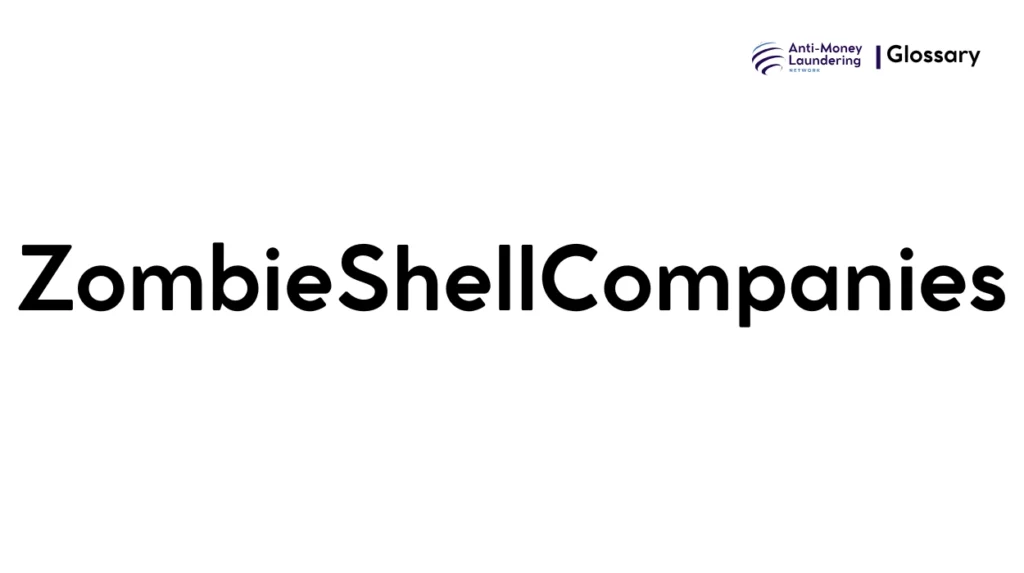Definition
Zombie Shell Companies refer to dormant or inactive shell companies that appear operational on paper but lack genuine business activities and resources. Unlike typical active entities, these companies have been left idle, often retaining registration and minimal formalities, yet they remain available for exploitation in illicit activities such as money laundering.
They act like “zombies” — legally existing but functionally dead — providing anonymity and a façade for layering illegal funds through complex ownership and transactions.
Purpose and Regulatory Basis
Role in AML
Zombie Shell Companies pose significant risks within Anti-Money Laundering (AML) frameworks by enabling concealment of beneficial ownership and source of illicit funds. Their inactive status makes due diligence challenging and increases the potential for misuse in schemes like layering and integration phases of money laundering.
Key Global/National Regulations
- FATF Recommendations: Emphasize transparency of beneficial ownership and enhanced scrutiny of entities with unclear activities, specifically mentioning dormant companies used to hide illicit flows.
- USA PATRIOT Act: Requires identification and verification of beneficial owners, extending scrutiny to all legal entities regardless of activity status.
- EU AML Directives (AMLD): Require member states to maintain registers of beneficial ownership and address risks from opaque corporate structures, including inactive companies.
These regulations seek to prevent Zombie Shell Companies from being a loophole in AML compliance by enforcing stricter KYC/KYB processes and transparency.
When and How it Applies
Real-World Use Cases and Triggers
- Dormant company reactivation: Reuse of inactive companies to disguise the origins of criminal proceeds.
- Complex ownership layering: Using zombie entities in chains of ownership to hinder investigations.
- Transaction monitoring red flags: Unusual transactions in otherwise inactive companies.
- Triggers for investigation: Lack of genuine business activity, inability to contact, or incomplete ownership disclosures.
Examples
- A company registered years ago but with no business history suddenly conducting high-value financial transactions.
- Multi-level shell company chains including dormant entities to obscure true beneficiaries.
Types or Variants
While broadly categorized as dormant or inactive, Zombie Shell Companies may manifest in several forms:
- Purely dormant shells: No financial activity but formally maintained.
- Reactivated shells: Dormant companies suddenly engaged in questionable transactions.
- Multi-layered shell networks: Where zombie shells are part of complex corporate hierarchies obstructing ownership clarity.
Procedures and Implementation
Institutional Compliance Steps
- Enhanced Due Diligence: Rigorous Know Your Customer (KYC) and Know Your Business (KYB) verifications focusing on dormant entities.
- Beneficial Ownership Identification: Using registries and independent verification to uncover hidden owners.
- Transaction Monitoring: Tailored surveillance to detect unusual activity in dormant accounts.
- Regular Reviews: Scheduled audits and verification updates for inactive companies.
- Use of Technology: Deploy advanced AML solutions, artificial intelligence, and machine learning to flag suspicious entities.
Systems and Controls
- Integration of comprehensive screening tools.
- Ongoing risk assessments.
- Automated alerts for anomalies.
Impact on Customers/Clients
From a customer perspective, engaging with Zombie Shell Companies may lead to:
- Increased due diligence and documentation requests.
- Possible delays or limitations on transactions.
- Enhanced scrutiny and potential regulatory reporting.
Legitimate clients must be prepared for thorough verification processes to reassure compliance.
Duration, Review, and Resolution
- Duration: Zombie Shell Companies can remain dormant indefinitely unless regulatory or enforcement actions are taken.
- Review: Institutions should conduct periodic risk reviews to assess dormant entities’ status.
- Resolution: Actions include updating records, termination of dormant companies, or filing Suspicious Activity Reports (SARs) when misuse is suspected.
Reporting and Compliance Duties
- Institutional obligations: Maintain accurate records, monitor transactions vigilantly, and report suspicious activities promptly.
- Documentation: Maintain audit trails of due diligence efforts and review findings.
- Penalties: Non-compliance may result in fines, sanctions, or reputational damage.
Related AML Terms
- Shell Companies: Parent term for entities without significant operations, including zombie variants.
- Beneficial Ownership: Identifying individuals who ultimately own or control entities.
- Layering: Money laundering phase where illicit funds pass through complex transactions.
- Corporate Transparency: Regulations addressing disclosure requirements.
Challenges and Best Practices
Challenges
- Opaqueness due to inactivity and lack of information.
- Difficulty in verifying beneficial owners.
- Complex multilayered ownership structures.
- Resource-intensive monitoring.
Best Practices
- Use cutting-edge technology for entity verification.
- Establish clear internal policies for dormant entities.
- Train staff to recognize red flags.
- Collaborate with regulators and other institutions.
Recent Developments
- Regulatory changes: Increasing mandates for public beneficial ownership registries.
- Technological innovation: AI-powered AML tools enhance detection of dormant entity misuse.
- Global coordination: International data-sharing initiatives improve transparency.
Zombie Shell Companies represent a unique risk in AML compliance due to their dormant nature yet potential misuse in laundering schemes. Understanding their definition, regulatory context, and practical detection and prevention methods is vital for compliance officers and financial institutions. Employing rigorous due diligence, advanced technology, and ongoing reviews can effectively mitigate these risks, safeguarding the financial system’s integrity.

